
Natya Sagara
2009 - Celebration of International Dance Day
- A Seshan,
Mumbai
e-mail: anseshan@gmail.com
May 20, 2009
The sixth
edition of NATYA SAGARA, an Indian classical dance competition, was organized
by the Kanaka Sabha Centre for Performing Arts, Mumbai, and www.kanakasabha.com
on May 3, 2009 at the premises of the Academy of Fine Arts and Crafts (AFAC)
in Chembur, Mumbai. As in the previous years, it was in commemoration of
the International Dance Day observed the world over to honour Jean-George
Noverre (1727-1810), the father of modern ballet, on his birthday that
fell on April 29. The objective is to bring all dances together on this
occasion, to celebrate this art form and its universality, to cross all
political and ethnic barriers and to bring people together in peace and
friendship with a common language - dance.
Contestants
| Category |
No. |
Duration
of performance (Minutes) |
| Junior (below
12 years) |
17 |
6 |
| Senior (12-16
years) |
12 |
6 |
| Special (16
years and above) |
5 |
10 |
| Total |
34 |
|
Bharatanatyam,
Kuchipudi and Odissi were represented. There were contestants from Pune
and Bangalore besides from Mumbai.
Panel of
Judges
Moli Siddharth:
Dance guru and choreographer for Bharatanatyam and Kathak
Mahathi Vijayprasad:
Bharatanatyam artiste / Carnatic musician
Usha Srinivasan:
Carnatic music vocalist for dance / teacher
Akila Satyanarayanan:
Bharatanatyam artiste and teacher
Following
the past convention, the names of judges were not revealed to the candidates.
Judges were also not informed about the gurus of the participants to ensure
objectivity. Students of Kanaka Sabha were debarred from registration to
avoid any conflict of interest.
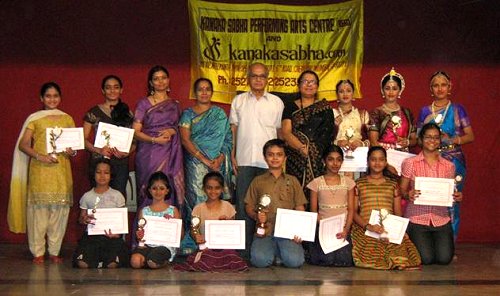 Prize Winners
Prize Winners
Junior
1. Vaishnav
Venugopal
2. Nadoran
Keerthi Pradeep
2. Janhavi
Uttam Ubhe
3. Nikita
Subramani
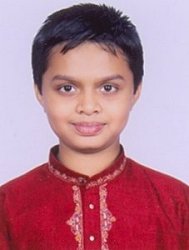 Vaishnav
Venugopal
Vaishnav
Venugopal
|
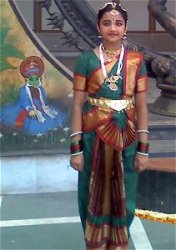 Nadoran
Keerthi Pradeep
Nadoran
Keerthi Pradeep
|
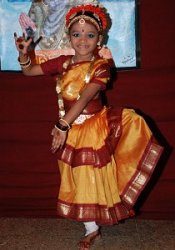 Janhavi
Uttam Ubhe
Janhavi
Uttam Ubhe
|
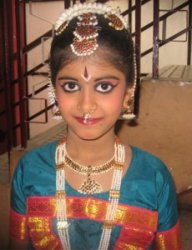 Nikita
Subramani
Nikita
Subramani
|
Consolation
Ashwathi Pramod
Disha Satish
Varghade
Sanjana Moodbagil
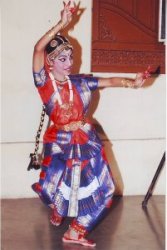 Ashwathi
Pramod
Ashwathi
Pramod
|
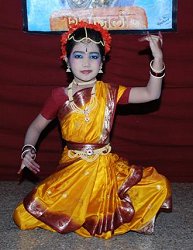 Disha
Satish Varghade
Disha
Satish Varghade
|
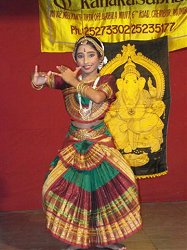 Sanjana
Moodbagil
Sanjana
Moodbagil
|
Senior
1. Nupur Pai
2. Ramya Krishnan
2. Krishti
Das
3. Deepshika
Mondal
3. Surabhi
Andrade
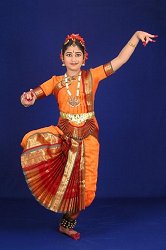 Nupur
Pai
Nupur
Pai
|
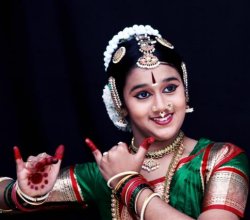 Ramya
Krishnan
Ramya
Krishnan
|
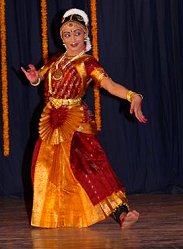 Krishti
Das
Krishti
Das
|
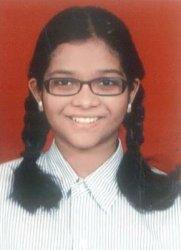 Deepshika
Mondal
Deepshika
Mondal
|
Special
1. Priya Singh
(Odissi)
2. Vani Venugopal
(Bharatanatyam)
3. Snehal
Phatak (Bharatanatyam)
 Priya
Singh
Priya
Singh
|
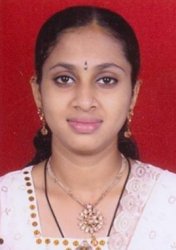 Vani Venugopal
Vani Venugopal
|
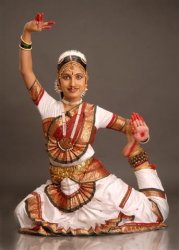 Snehal
Phatak
Snehal
Phatak
|
The Contest
As observed
in the past reviews, the average standard has been going up year after
year despite the variations in individual performances. It was obvious
that the participants had taken the event seriously and undergone intensive
training for the day. It was heartening to see so many youngsters, especially
the tiny tots, dancing without any stage fright and completely devoted
to giving their best to impress the judges and the audience. Due to the
limited number of participants the entire program could be staged in the
main hall. It was a spin-off for this reviewer. Thus he could see all the
performances at one place for the first time. In the past, due to larger
participation, the competition for different categories was held simultaneously
in two other rooms also making it a difficult choice for the rasikas.
A few comments
on the performances would be appropriate to highlight certain features
observed by this writer. The close nature of the contest was evident from
the fact that some prizes had to be shared.
Special
Category
Priya Singh,
who secured the first prize in the Special Category, has the personality
of an Odissi dancer. Her tribhangi and chauk (asymmetrical
and symmetrical poses) were near perfect. The chalas (torso movements)
and the charis (movement of the feet) were executed well. Although
she exceeded the time limit, what impressed the judges must have been her
emoting on the stage in bhakti sringara in a colourful and convincing manner
for a Jaidev ashtapadi in a raga that sounded like the Carnatic Malahari.
Vani Venugopal's Sriranjani item ("Sami nee") had a tough pose to
end with, which she managed well. However, her performance had to be cut
short due to the time limit. "Mate Malayadhwaja" in Khamas, composed
by Muthiah Bhagavatar, is a daru varnam popular among dancers and
rasikas; it is quite challenging. Snehal Phatak rose to meet the occasion.
She managed the sancharis well presenting different events in Goddess Meenakshi's
life and executed such adavus as Murukku Adavu, Nattu Adavu and
Kuditta Mettu Adavu in an exemplary manner. The sanchari bhava of bhakti
came through well. However, she also ran short of time. Aarti Naidu's Miyan-ki-Todi
(Subhapantuvarali in Carnatic music) item was yet another instance of aesthetic
adavus. Anusuya Dutta's addamis were attractive.
Senior Category
It was clear
that the selection of songs is the first step to success at such contests.
Mellifluous music, recorded well, is a source of encouragement to the artiste
besides being pleasing to the judges and the audience. This was evident
from the very first performance of the day by Nupur Pai, who set the ball
rolling and the contest going. She secured the first prize in the Senior
Category. Her item in Nattakkurinji in obeisance to Lord Ganesh made a
good start for the event. The word "Navarasa" in the song was exploited
in a sanchari mode for the portrayal of the nine rasas with an impressive
mukhajabhinaya. She was resourceful enough not to exceed the time limit.
Her frequent araimandis were done in the correct position.
Ramya Krishnan's
Natesa Kavuthuvam ("Dheem dheem") was impressive and had
the support of mellifluous music recorded well, as in the previous instance.
Amantrita Mondal's Odissi was noted for the execution of some difficult
karanas and an electrifying ending. Whether in music or dance, stylistic
conclusion is a major plus point in impressing viewers. Kathak dancers
excel in finishing an item with the flourish of a statuesque pose. Others
could emulate them. Debarati Bhowmik is another contestant to be mentioned
in this context. Her dancing to "Ananda natanam adum Vinayaka" in
Gaulai, ended in four different poses held in steadiness.
A few bravehearts
attempted to present capsule versions of varnams. It requires good guidance
from gurus to do this successfully. Surabhi Andrade was a good dancer who
could not finish "Nathanai" in Kambodhi in time. Sindhuja Bheesette
danced well to Sankarabharanam but she was handicapped by poor recording
of music. It is important that the articulation of words is clear in the
recording for the audience to understand the theme of the song. This problem
was observed in a few other cases also. Ruchita Jamanji was the only participant
from Kuchipudi style. Her adugulus, sancharis and response to jatis in
a song in Sriranjani were all of a good standard and she executed some
deep-seated positions effortlessly. Sonia Malgundkar's Tilang piece was
noted for uninhibited dancing.
Junior Category
Vaishnav Venugopal,
the one and only male contestant, justified his unique position carrying
the day winning the first prize. He impressed everyone from the beginning
to the end with his effortless execution of adavus, adhering to the rhythm
and making a full use of the stage in dancing to "Neeraja" in Kalyanavasantam.
Nadoran Keerthi Pradeep was yet another contestant who had the advantage
of good and well-recorded. music. Her dancing to "Nanda nandana"
of Narayana Tirtha in ragamalika in such evocative ragas as Sriranjani,
Dwijavanti, Kalyanavasantam and Madhyamavati made the grade. Little Janhavi
Uttam Ubhe danced into everyone's heart with her joie de vivre in
performing to a ragamalika. She was sprightly and danced like someone with
years of experience. She got the loudest approbation from the audience.
Nikita Subramani's was one more case with a dramatic ending (Purandaradas's
"Narayana Hari" in Shanmukhapriya). Ami Mehta too danced the Natesa
Kavuthuvam but ran into the time barrier. Ashwathi Pramod was among the
few contestants who attempted utplavanas (jumps) to a medium height. Her
song was "Ananda nadamidum padam" in Surati.
It is noteworthy
that all the songs were in Adi. At the current stage of their artistic
development, youngsters would do well to concentrate on this tala with
easy even numbered beats in angas before graduating to more difficult
rhythms and cross rhythms.
General
remarks
We are living
in a fast jet age of instant idlis and capsule courses in many disciplines.
So it is but natural for contestants to attempt in a short time a heavy
item like varnam, which is the ultimate test of a Bharatanatyam dancer's
prowess. But then they have to be judicious in selecting the sahityas
and just try to give only a sample of each element like abhinaya, nritta,
sanchari, etc. If one were to dance to a song with a reference to Dasavatara
it would be difficult to cover all the incarnations within the stipulated
time. The strategy should be to select a song where the sancharis could
be cut down to a minimum. This reviewer had seen some participants doing
this successfully in the previous years. Gurus should guide their students
in this matter.
The candidates
are judged on the basis of their performances in different aspects, viz.,
abhinaya, adavus, rhythmic control, etc. The effective portrayal
of abhinaya depends on expressive eyes or a mobile face. One has
to be naturally endowed with these features. On the other hand, notwithstanding
the concept of body language (kinesics of Laban), adavus are more physical
than emotional and depend on the skill of the dancer in portraying them
aesthetically and according to the sastras. The benchmark in this department
of dance is anga shuddha. Inter alia, it refers to perfection
in sthanaka, chari, hastakshetra, nritta hasta and mandala.
After seeing the performances, this writer felt that gurus need to identify
the strong and weak points in anga shuddha and concentrate on the
areas where more intensive training is required.
The importance
of ending a dance item with a flourish was emphasized earlier. A dance
artiste should be aware also of the impact of an electrifying entry to
the stage. This writer still remembers, after a half century, the manner
in which Kumari Kamala, as she was called then, used to make a dramatic
entry perking up the audience. She would run around the stage like a deer
with lilting steps and pay obeisance to the gurus, the other members of
the orchestra and the audience. As in life, the first impression is often
the last and lasting impression. Although today there may not be a nattuvanar
on stage, the cassette or CD player having usurped his role, the artiste
can still make the entry impressive a la Kamala. For example, a
fast dancing entry would be more eye-catching than a slow stroll like one
walking into a living room. Saushtavasthanaka in Bharatanatyam or
Poorvarambham in Kuchipudi performed in the correct manner at commencement
can be the first step to a successful performance.
One of the
benefits of attending music or dance competitions is that one comes to
know of sahityas or ragas not heard before. It is an educative process
not only for the general audience but also for the critic and the connoisseur.
For example, this writer came to know about Natesa Kavuthuvam after seeing
its performance at the contest. Kanaka Sabha should consider announcing
the sahitya, raga, tala and composer before any contestant ascends the
stage. This is all the more necessary when the recording of music or the
articulation of sahitya is not satisfactory enough to identify the pallavi.
Arrangements
The program
was compered efficiently by Vidhya Mani. Registration for the contest was
handled by Archana Shetty, Punitha Selvaraj, Rajeswari Nair, Muthulakshmi
Nadar and Shivaranjani Moopanar. The food counter was in the charge of
Bharati Moopanar and Muthulakshmi Nadar. Bhuvana Selvaraj kept time. The
other volunteers were Sreelesh Nambiar, Chandrika Shetty, Nimisha Nair
and Rumya Nataraj. Surekha Radhakrishnan and Sarikha Shetty were in overall
charge of the program.
Wrap up
It was creditable
on the part of the organisers to have made excellent arrangements for the
smooth conduct of the proceedings without any hitch even though their gurus
–Saroja Srinath and Dr. Siri Rama - could not be present due to other engagements
in Singapore, where they reside. Of course, they were the invisible and
long-distance guides to the organisers! The extent of participation saw
a sharp decline from 90 last year to 34.
Kanaka Sabha
should reflect on the possible reasons thereof. This writer feels that
May 3 was perhaps not the best time to attract youngsters when most of
them would be having their vacations outside the city. Further, the long
weekend (April 30 through May 3) due to holidays saw many in the city going
out. This had affected the general election in the city too on April 30
when polling was marked by the voting percentage in the lowly 40s. Last
year's timing (June 1) in the first week of June seems to be ideal. Many
students would return by that time to the city to prepare for attendance
at educational institutions in the new academic year.
The author, an Economic Consultant
in Mumbai, is a music and dance buff. He thanks Vidhya Mani, Surekha Radhakrishnan
and Sarikha Shetty for the assistance received in getting the details of
the competition. |


